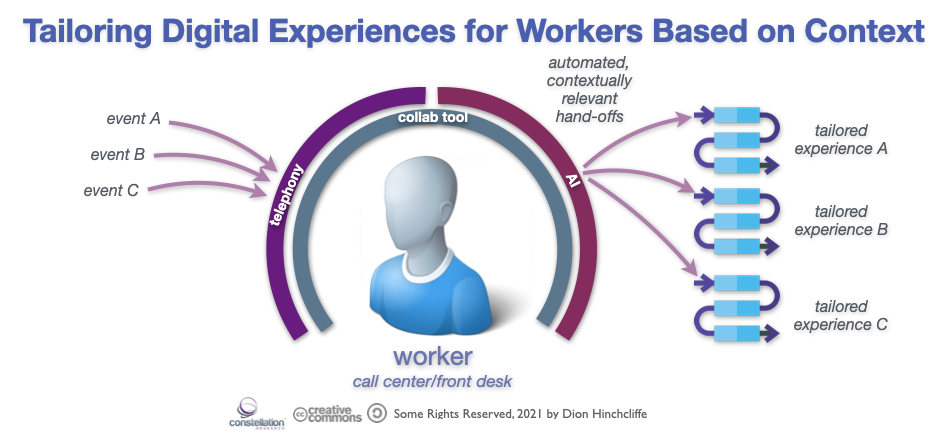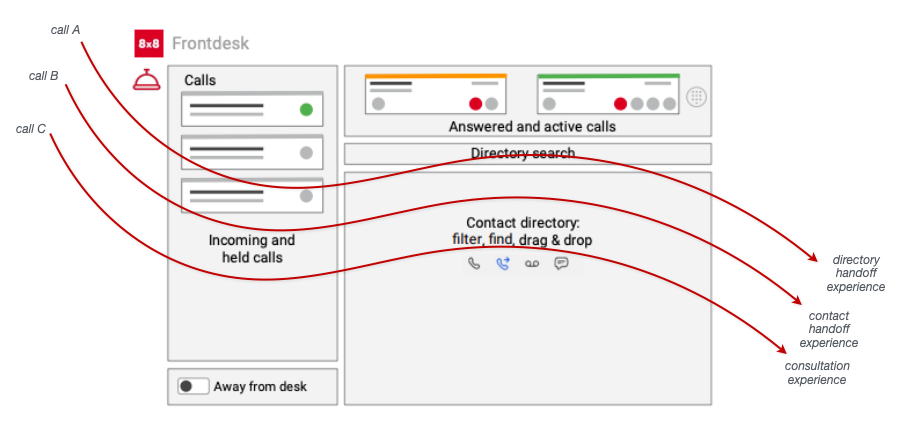Today’s technology-centric workplaces make it challenging for employees to quickly and effectively engage with common tasks in their work environment. It’s not that there is too much technology, but that it is situated in a way that lacks context and does not directly support the specific flow of work at hand.
In my research on digital employee experience, most digitally-enabled processes are built as functional silos. This means they don’t take into account the overall work experience or the other applications and channels that are used by the worker to complete a task. While it’s still challenging to design end-to-end digital experiences for general purpose knowledge workers, it’s become evident that the industry is closing in on solutions for semi-structured work for certain roles, such as call center operators or front desk workers.
In fact, I am seeing that more organizations than ever today are creating more tailored and customized employee experiences across channels and functions so that workers can focus on the work and not the underlying technologies. Organizations are doing this out of necessity to achieve certain needed benefits such as to reduce employee onboarding time, cut down on training, improve productivity, or reduce errors.
Where and How to Tailor Employee Experience for Better Outcomes
It turns out that one of the best places to guide and personalize the employee experience across functions and channels is in the collaboration tools that workers use daily. These are already the nexus for many key processes that involve more than a single person, and they are a natural location to bridge multiple channels and applications in the process as well.
Figure 1: How work events can be mapped to tailored experiences
For this tailoring of employee experience to work, however, it requires some adaptation to the process at hand. Relevant responses, including capabilities like auto-generated next best action, to important and/or common situations should be presented to the user when an appropriate situation occurs. Contextually significant data should be filtered and shown in response to gating events in the worker's activities, such as which step should be performed next or who to hand the next step off to when it’s complete.
An Example of Tailored Experiences: 8x8 Frontdesk
A useful example of how personalized and contextual experiences can be provided to workers to achieve the aforementioned benefits is with the new Frontdesk solution by cloud-based voice, collaboration, and customer engagement provider 8x8.
By entirely virtualizing the communications environment of the knowledge worker, a specialist contact center agent or front desk worker, Frontdesk provides businesses with the agility to dynamically assign roles to any user that is available and capable. This is an integral part of the software category known as eXperience Communications as a Service (XCaaS), which realizes an integrated cloud platform for contact center, voice, video, chat, and APIs. 8x8 Frontdesk is a new XCaaS composable experience aimed at the need for a dynamic receptionist solution for high-volume call handling. It consequently enables communication services to be available to anyone who can perform the work, from any location without special hardware.
Figure 2: How Frontdesk maps high frequency events to specifically tailored experiences
By completely virtualizing the call center worker or front desk operator, 8x8 Frontdesk extends their role to any user that is available and willing, as an integral part of their integrated cloud platform for contact center, voice, video, chat, and APIs. The solution is delivered entirely via software to anyone who can perform the work, from any location dynamically without special hardware.
What sets it apart from previous solutions is 8x8 Frontdesk offers a personalized solution for receptionists that is easily enabled in the same communications and collaborating app used across the entire organization, with centralized answering for both employee extensions as well as contact center agent user groups. Designed for a shallow learning curve aimed at speeding user adoption and time-to-value, the product provides contextual assistance with quick action icons for single-click call connections based on the caller and their likely destination, with pre-scripted greetings provided to the worker for the relevant inbound call. Voice and message-based call consultation capabilities are also provided that speed workers to the right internal contact.
The result is a solution that just about anyone can use with minimal training, maximum confidence in their actions, and significant efficiency boosts that greatly reduce time to task completion.
What Organizations Can Do To Maximize the Results of Tailored Experiences
While it’s helpful to have solutions that allow the tailoring in the first place, the key is to provision them upfront with data, filters, and contextually relevant content. Today, much of this setup is done in the solution design itself, freeing up the organization to deploy it seamlessly, as the use cases are already developed and realized with most of the tailoring already done for the situated work process. This enables organizations to outcompete using the strength of their customer/worker journeys.
The following should be considered by organizations to get the most from tailored experiences:
- Specifically seek out solutions that realize tailored experiences at the junction between multiple people and systems. Collaboration scenarios such as call centers tend to have the most contextual relevant value that is easy to tailor repeatedly and reliably at scale.
- Look for use cases in commonplace, high frequency collaboration scenarios that will deliver high ROI due to volume-based increases in speed, performance, reliability and reduced errors.
- Test and validate the tailored experiences to ensure they actually deliver the benefits expected, configuring or customizing them as needed until the desired level of performance is achieved.
In today’s complex and high velocity workplaces, tailored experiences can deliver signal from the noise and ensure workers are a) focused on task , b) proactively enabled in their common processes, and c) able to quickly learn what they to do, deliver on it, and ensure the high quality of their resulting work activities. Organizations that seek to gain the highest performance for their digital workplaces will seek out solutions that contextually enable their workers, especially at the point of communications and collaboration, to carry out their activities with as much relevant, in-experience support and personalization to task as possible.
Additional Reading
Realizing a Decisive Advantage in Digital Commerce Through Economic Flexibility
Reducing Team Communications Silos to Rapidly Increase Usability, Adoption, and Lower Support Costs




